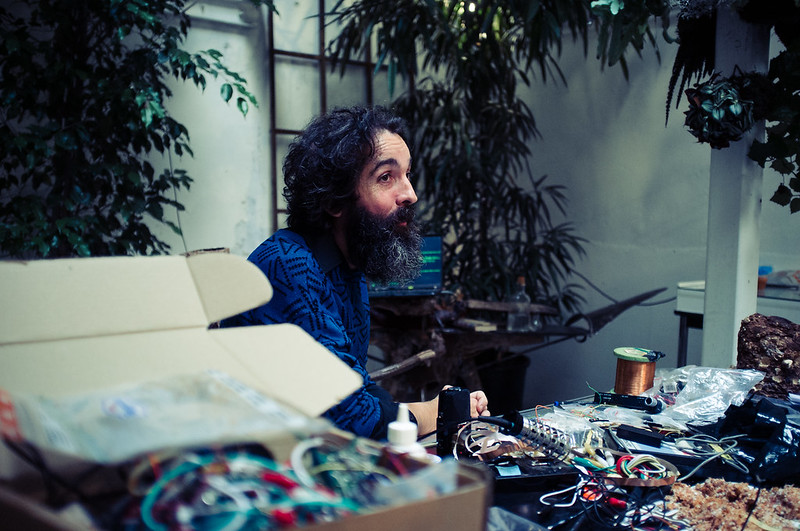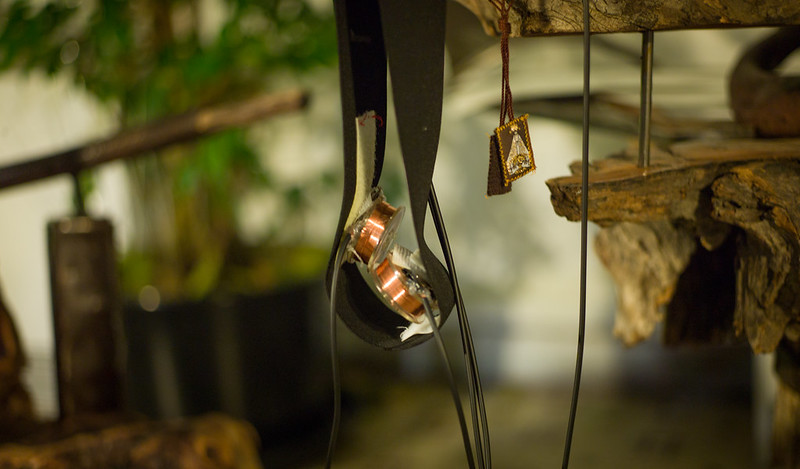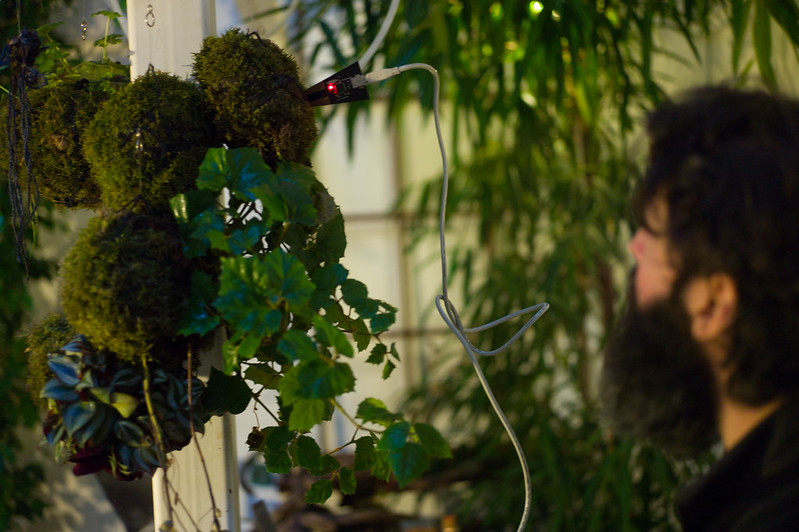This is an old revision of the document!
Table of Contents
Approaching the Inexplicable
Nik Gaffney and Martin Howse
“A mycelial network has no organs to move the world, no hands; but higher animals with manipulative abilities can become partners with the star knowledge within me and if they act in good faith, return both themselves and their humble mushroom teacher to the million worlds all citizens of our starswarm are heir to.”
–Terence McKenna, “The Mushroom Speaks”

No hands
In the slow swarm of light they remain silent, luminous. Eyes in the place of eyes, Ears in the place of ears, tongues tasting chemical gradients across the fungal network of thread-like cells. A truly underground communications network, spreading through the vastness of earth substrate, acting with ecosystem intelligence to form interfaces across symbiotic networks of root chatter.
And in the darkness, signalling separation, handless. A darkness eyeless or rather of only starswarm senses. Zero the bridge, null the meters. A pause allowing reflection, a tea break in the glass house, brewed roots amongst the hanging foils and foliage, microscopic memories.
The forest smell of earth-veiled mycelium; observation of patterns, fairy-ringed, white bulbous mushroom growth, and the first taste of the peeled muscaria itself suggests another, perhaps more constructive, microscopic interface. Sniffing, chewing, sipping the earth substrate by way of those roots.
Radio static saprophytics humming in mute backgrounds, chance shifts to patterns of cross-spore germination between two parallel wide area networks; between radio-based communication technologies and the single organism network of the mycelium; between the moment and the shadow. Fungal transceivers sprout mycelial antennas, a forest on the head. The influence of electromagnetic carrier wave on the mycelial network asks to be examined.
Plastic dishes of MYA (malt, yeast, agar) necklace-like, strung together on coils of thin copper wire; a hanging garden of reception and transmission, rough interface to the mushroom mind. On the FM band: power line undulations, low frequency pulses, phase shifts manifest, chatter.
The gradual diversity of human networks follows and maps across fungal diversity in urban niches. Root chatter and interface; mobile phone base station saprophytes decomposing dead office buildings. And again those patterns, fairy rings of plastic-caulked masts, exactly the same whether in the forest or city, the same influencing fields. The magnitude of the magnetic field falls off as the inverse cube of distance, an empty centre devoid of muscaria, no network, no signal. In this case, imagining the parallel, a truly underground (W.A.S.T.E) network.
Radio mycelium
The well-documented transformative potential of the mycelium (decomposing pollutants, purification, necrophagy, saprophagy) is invoked to remediate an increasingly pathogenic electromagnetic networked culture. compost for sterile soils. refraction, reflection and interference. The mycelial network structures perception as diffusion patterns, granular obstacles, listening at the level of thermal noise. the radio crackles. tangles left unexplored, unexplained. further. Plants and fungi form part of an essential and idiosyncratic psychic chemistry. time perception may be shifted. time binding may require loosening. detection barely above the level of thermal noise.
The attempt to find a particular, quantifiable channel of communication with plants, less often with fungi, has fuelled a long enquiry, spanning the work of researchers such as Jagadish Chandra Bose, Cleve Backster and L. George Lawrence, often relying on electronic means of “biodynamic signalling” and expectations of shared reference frames. Thermal noise, pattern cascade.
After Franz Mesmer, there is a shift from animal magnetism to mycelial/plant electricism; an electrical theology established as the other history (against the day of Franklin) of electromagnetism. Electricity as a fire, a light (luminous), a soul, a living fluid coursing through veins, roots and matter, uniting man with animals, plants and all things. Behind the veil of science and measurement, electronic plant/fungi communication suggests a new form of contemporary animism.
Electromagnetic means of this inter-species communication focuses primarily on either a change in electrical resistance within parts of the plant or fungus, exactly how much the plant cells resist the easy flow of a signal, or on the measurement of micro-voltages or electrical potentials between two points in the plant. Most vascular plants exhibit 2 classes of such signals, the rapid “action potential” (AP) and the slower “variation potential” (VP). patterns of signals arc across time. Time perception may be shifted in a thickening of temporal bandwidth. Time binding requires loosening.
Plants are cast within these endeavours as detectives and detectors, pinned to the human subject, as psychic guides and indicators. Experiments attempt to quantify and correlate psychic stress (measurable as skin currents) with plant micro-motion (Mimosa pudica) and these potentials. The hypothesis is rejected, although there is some evidence of correlation. Detection barely above the level of that mossy, thermal noise floor.
Plants and fungi sense, transform and adapt. They speak with each other and in this conversation acknowledge clear changes in the earth. On a mundane level becoming indicators of changes in soil chemistry, watchers of shifts in weather, observers of seasons and migratory transformation. The forest bed, a base of earth, decay and moss, turns over on itself in a sedimentary churn; the slow process of earth coding, working perhaps through and towards a “mind of mud“, a starred mushroom mind swallowing the observer. salt crystal taste. entropy on the tongue.
Photonic exchanges
The Mycelial Photon Exchange InstRument (aka. MPEIR) and cortical EM microfield induction (aka. CEMMI) produce a hybrid sensory device; photonic exchange in the realm of sight; electromagnetic exchange in the realm of perception. Panellus stipticus mycelium grows through moistened wood shavings (after two weeks' dark). luminous. luminescent. living.
“The first trial (MH) with coils attached in proximity to occipital lobes, the second trial (NG) with coils close to temporal lobes. In both cases, no effects could be discerned other than those attributable to concentrated self observation.” Dual magnetic coil amp (10~20 milligauss) controlled in parallel, symmetric and asymmetric induction patterns. ferns as signal source. low frequency chaotic modulations (5-10Hz)
Field testing. Bound to a tree in a park in Ghent, a subject strapped to the root system. CEMMI apparatus taps into the earth root. Fluctuations in earth voltage, micro-coded earth assembly, modulate the flow of electricity through these coils, generating a magnetic field (falling off as the inverse square) which, according to certain theories, should re-code the psyche. A literal conceit invoking a real network.
Darwin's saprophytic typewriter
A mycorrhiza forms a symbiotic (generally mutualistic, but occasionally weakly pathogenic) association between a fungus and the roots of a vascular plant (ecto- and endomycorrhizal – outside and inside of roots). The network is the organism. Rhizomorphs as specialised, high-conductivity organs (developed by saprotrophic and ectomycorrhizal basidiomycetes). Tapping at the metaphase typewriter, statics primed with “The Power of Movement in Plants” by Charles Darwin. We create noise. We create statistical proto-meaning. Without the shared reference frame, we can only remain silent, categories are no use here as ontology gives way to the laughter of epistemology. we move toward the light. we take time. cycling.
Further Reading
- Radio Mycelium http://lib.fo.am/radio_mycelium
- Mycellial Photon Exchange InstRument http://lib.fo.am/mpeir
- silent dialogues notes http://lib.fo.am/silent_dialogues_notes
- Mckenna, T. The Archaic Revival. (HarperCollins, 1992).
- Stamets, P. Mycelium Running. (Ten Speed Press, 2005).
- Darwin, C. The Power of Movement in Plants. (1880).
- L. George Lawrence, More Experiments in Electroculture. http://www.swtpc.com/mholley/PopularElectronics/Jun1971/PE_Jun1971.htm
- Gagliano, M., Mancuso, S. & Robert, D. Towards understanding plant bioacoustics. Trends Plant Sci. 17, 323–5 (2012). doi:10.1016/j.tplants.2012.03.002)
- Journal for Plant Signalling and Behaviour. http://www.landesbioscience.com/journals/psb/
- Pendell, D. Pharmako/Gnosis, Revised and Updated: Plant Teachers and the Poison Path. (North Atlantic Books, 2010).
- Benz, E. The theology of electricity: on the encounter and explanation of theology and science in the 17th and 18th centuries. (Pickwick Publications, 1989).
- Smithson, R. Robert Smithson: The Collected Writtings. (University of California Press, 1996).




